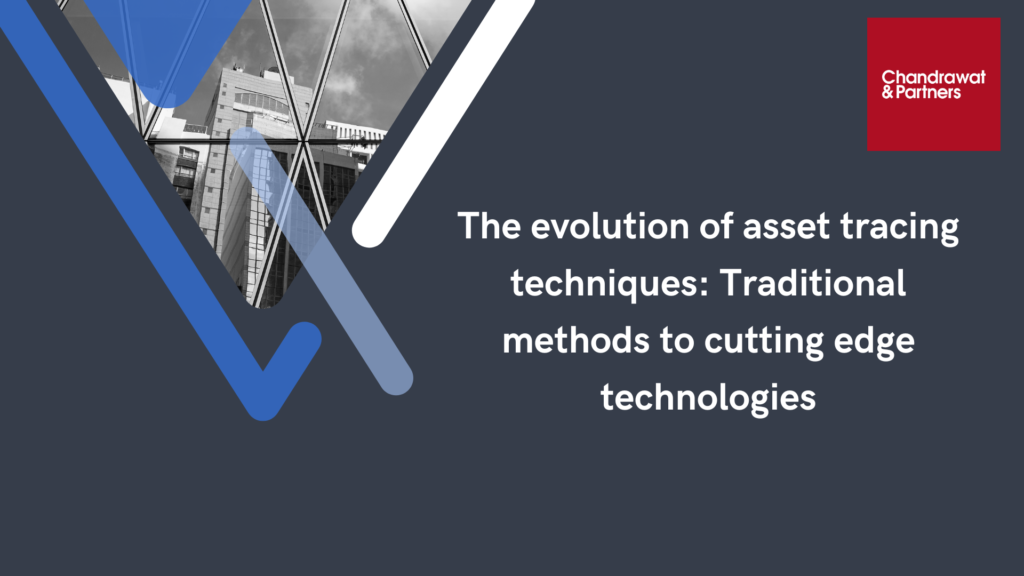Edit Content
Edit Content
Edit Content

Asset tracing has become increasingly vital in today’s complex financial landscape. It involves the process of locating and recovering assets that have been concealed, misappropriated, or otherwise hidden. Traditional asset tracing methods were labour-intensive and relied heavily on manual processes. However, with advancements in technology, innovative techniques have emerged, transforming the asset tracing landscape. It is important to explore the evolution of asset tracing techniques, from traditional methods to cutting-edge technologies, highlighting the benefits and challenges associated with each approach.
Asset tracing techniques have evolved significantly over time, moving from labour-intensive traditional methods to sophisticated, technology-driven approaches. Respecting privacy, ensuring data security, and complying with legal and regulatory frameworks are crucial for maintaining the integrity and legitimacy of asset tracing efforts. As technology continues to evolve, asset tracing techniques are likely to become even more advanced. It is crucial for asset tracing professionals, lawmakers, and organizations to stay abreast of these developments, adapting their practices and regulations to ensure effective and ethical asset tracing in an increasingly complex financial landscape.
Traditional asset tracing methods relied on time-consuming and manual processes. These methods often involved extensive research, gathering and analysing paper documents, interviewing individuals, and employing surveillance techniques. While effective to some extent, these methods were limited in terms of their efficiency, scalability, and speed.
One common traditional asset tracing method is public records searches. Investigators would manually comb through various public records, such as property records, court filings, and business registries, to identify assets owned by individuals or organizations. This method was valuable but time-consuming and prone to errors or omissions due to incomplete or outdated information.
Another method involved physical surveillance and investigation. Investigators would monitor individuals’ activities, such as tracking their movements or observing their financial transactions. While this approach could yield valuable information, it was resource-intensive, limited in scope, and easily detectable.
The advent of cutting-edge technologies has revolutionized asset tracing, allowing investigators to streamline and enhance their efforts. Here are some notable advancements in asset tracing techniques:
While cutting-edge technologies offer significant advantages in asset tracing, they also come with challenges and ethical considerations. Some of these include:
The integration of data analytics, AI, blockchain analysis, digital forensics, and predictive analytics has enhanced the efficiency, accuracy, and speed of asset tracing. These cutting-edge technologies enable investigators to uncover hidden assets, trace financial transactions, and detect patterns that were previously challenging to identify. However, it is essential to navigate the challenges and ethical considerations associated with these advancements.
Our firm has specialized attorneys with expertise in asset tracing, financial investigations, and the relevant laws and regulations. We utilize data analytics and AI tools to process large volumes of information, enabling us to identify patterns and connections relevant to asset tracing. We can employ legal tools and mechanisms, such as subpoenas and court orders, to gather information from relevant parties and financial institutions. We can initiate legal proceedings to freeze assets, obtain restraining orders, or recover misappropriated funds on behalf of our clients. For international asset tracing, we collaborate with legal counterparts in different jurisdictions to navigate complex legal landscapes.
For more information or queries, please email us at
[email protected]

Managing Partner
Copyright © Chandrawat & Partners. All Rights Reserved.
Copyright © Chandrawat & Partners. All Rights Reserved.

Chandrawat & Partners stands as a dynamic and rapidly expanding full-service firm, specializing in the delivery of exceptional professional and corporate services to a diverse clientele, both foreign and local. We proudly represent companies and individuals across a wide spectrum of sectors through distinct entities established in various countries worldwide.
ASIA
AFRICA
EUROPE
NORTH AMERICA
SOUTH AMERICA
OCEANIA
Chandrawat & Partners uses cookies to run our site and improve its usability.
By using our site you agree to our use of Cookies.